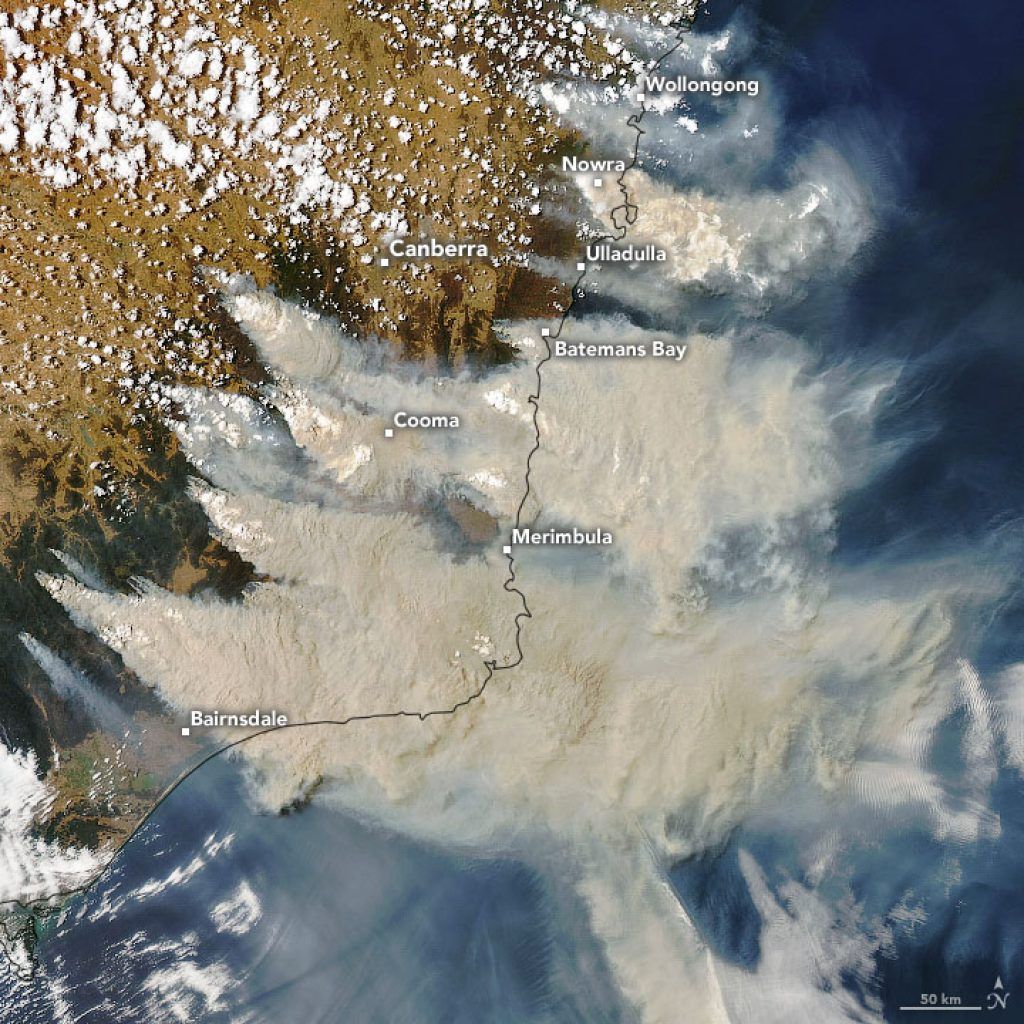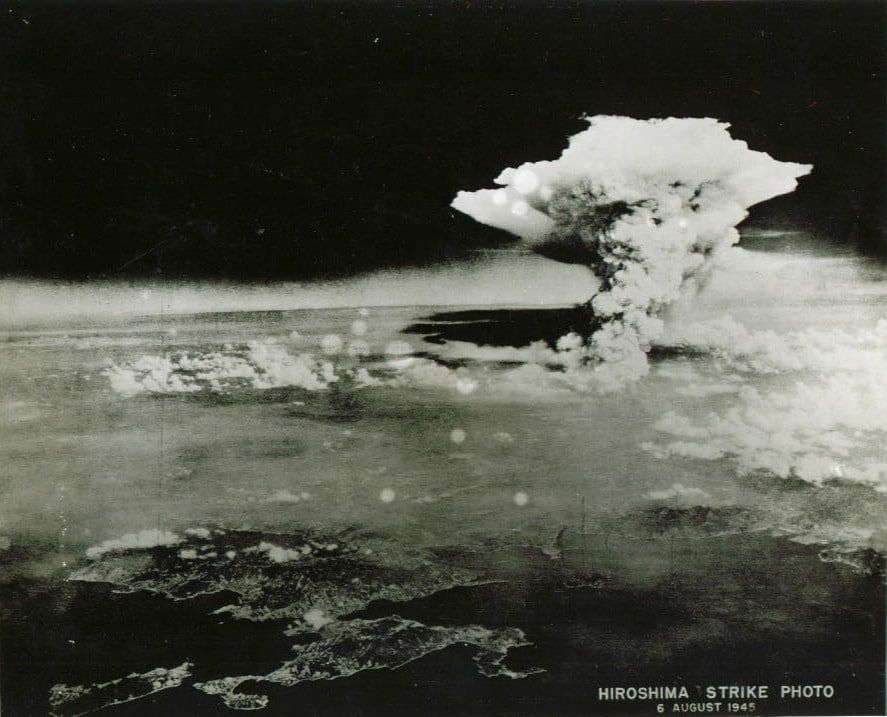Australia’s “firenadoes” summon images of Hiroshima, atomic bombs
By Dawn Stover | January 14, 2020
 Taken by NASA’s Aqua satellite on January 4, this image shows smoke from fires burning in southeastern Australia. NASA says it is likely that some of the white patches above the smoke are pyrocumulonimbus clouds, which resemble violent thunderstorms and can form above intense fires. Credit: NASA Earth Observatory image by Joshua Stevens
Taken by NASA’s Aqua satellite on January 4, this image shows smoke from fires burning in southeastern Australia. NASA says it is likely that some of the white patches above the smoke are pyrocumulonimbus clouds, which resemble violent thunderstorms and can form above intense fires. Credit: NASA Earth Observatory image by Joshua Stevens
The massive fires in Australia have killed 28 people so far and an estimated 1 billion animals, destroyed thousands of homes, and burned more than 26 million acres—an area about the size of Kentucky. But are they comparable to the atomic bombings of Hiroshima and Nagasaki, which immediately killed at least 2,500 times as many people?
Some Australians think so.
“It has been absolutely devastating,” said Michael Pengilly, the mayor of Australia’s fire-ravaged Kangaroo Island, which is Australia’s third-largest island and a haven for wildlife. “The north coast looks like it has been hit by a nuclear bomb.”
“I’ve got to be honest with you, this isn’t a bushfire, it’s an atomic bomb,” Andrew Constance, transport minister for the Australian state of New South Wales, told ABC Radio. “It’s indescribable the hell it’s caused and the devastation it’s caused.”
Why are Australians making these comparisons?
The similarities. The fires in Australia are definitely producing some results similar to an atomic bombing. Eerie skies and billowing smoke. Vast stretches of scorched earth. Senseless and heartbreaking loss of life. The obliteration of homes and everything inside them. Potential long-term health effects.
I asked Lynn Eden, author of Whole World on Fire and a member of the Bulletin’s Science and Security Board, why some Australians see a connection between horrific fires and atomic bombings, and she pointed out two big similarities: First, the immense damage—though at different scales. The Australian fires have burned an area thousands of times larger than the area destroyed by fire at Hiroshima, which was about 4.4 square miles or approximately 2,800 acres. “These fires are on a scale the immensity of which is difficult to grok.”
Second, Eden says, “it appears that some of the fires in Australia are so large that they create their own weather.” As with the firestorm that followed the Hiroshima bombing, “the heat is so intense that, as it rises, it sucks air on the ground inward, which further intensifies the fire, causing total destruction,” Eden says. Government researchers call this sucking-up of air a fire whirl or “firenado.”
Along with firenadoes capable of ripping roofs off houses, Australia’s bushfires are producing pyrocumulonimbus clouds of smoke that can tower tens of thousands of feet and generate their own lightning and thunder. These clouds remind many people of the mushroom clouds associated with nuclear war—and mushroom clouds, which can form after large, non-nuclear explosions or volcanic eruptions as well as nuclear detonations, are in fact pyrocumulonimbus clouds.
The firestorm ignited by the Hiroshima bombing produced a pyrocumulonimbus cloud that caused a sooty rain to begin falling on the city about 20 minutes after the detonation. For decades, photos of this cloud were misidentified as the mushroom cloud created by the initial blast, which was not as tall or as long-lived.

The differences. There are, of course, some very obvious differences between bushfires and atomic bombings. The bombs dropped on Hiroshima and Nagasaki killed tens of thousands of people immediately—a number that dwarfs the death toll from Australia’s most lethal bushfires, the Black Saturday fires of February 2009, which killed 173 people. Many people in Japan who initially survived the 1945 bomb blasts and firestorms later succumbed to radiation sickness, burns, and other severe injuries. Others suffered excruciating lifelong pain.
This is not to diminish the experiences of those in Australia who are facing hellish conditions and doing their best to survive and to aid their fellow citizens. They have never personally experienced the horrors of nuclear war, so it’s understandable that they may simply be using “atomic bomb” to mean “the worst thing I can possibly imagine.”
Climate suicide. It’s not like Australia had no warning. Bushfires are routine and natural in Australia, but a 2008 report warned that climate change would make these fires “start earlier, end slightly later, and generally be more intense,” with these effects increasing over time and “directly observable by 2020.” Australia is now “experiencing a climate emergency,” reports climate scientist Michael Mann of Pennsylvania State University, who is taking a sabbatical in Sydney to study the connections between climate change and extreme weather events. Last year was the country’s hottest, driest year on record.
Sadly, Australia’s top leaders continue to deny a link between their country’s extreme bushfires and climate change. At the recent climate summit in Madrid, Australia’s government opposed ambitious actions to cut carbon emissions. Australia has a powerful coal lobby, and the biggest net coal exports of any nation. It also has Rupert Murdoch, who owns a number of newspapers and TV stations that have (wrongly) claimed this year’s fires are nothing new.
Australian Prime Minister Scott Morrison has been widely criticized for vacationing in Hawaii during his country’s bushfire crisis, and then greenlighting a New Year’s Eve fireworks display in Sydney. “I can think of no better time to express to the world just how optimistic and positive we are as a country,” said Morrison, who until recently resisted acknowledging any connection between his country’s “natural” disaster and its changing climate.
“Such are those who would open the gates of hell and lead a nation to commit climate suicide,” wrote Australian novelist Richard Flanagan in a recent opinion piece.
Perhaps it is not surprising that some people liken the horrific bushfires to nuclear Armageddon. In a Washington Post piece published last week, editorial writer Molly Roberts noted the prevalence of mushroom clouds and other World War III memes on the Internet at the outset of 2020, some in response to the recent US airstrike that killed a top Iranian commander. People who are living through the inferno in Australia’s “war zone” are experiencing powerful emotions—fear, rage, sadness, despair—that sometimes get distilled into what Roberts described as a “ready-made tableau: bullets everywhere until an atomic bomb arrives to blow it all away.”
Together, we make the world safer.
The Bulletin elevates expert voices above the noise. But as an independent nonprofit organization, our operations depend on the support of readers like you. Help us continue to deliver quality journalism that holds leaders accountable. Your support of our work at any level is important. In return, we promise our coverage will be understandable, influential, vigilant, solution-oriented, and fair-minded. Together we can make a difference.
Keywords: Australia, atomic bomb, fires, pyrocumulonimbus cloud
Topics: Climate Change, Nuclear Risk, Nuclear Weapons














